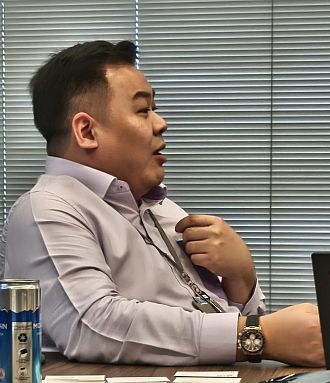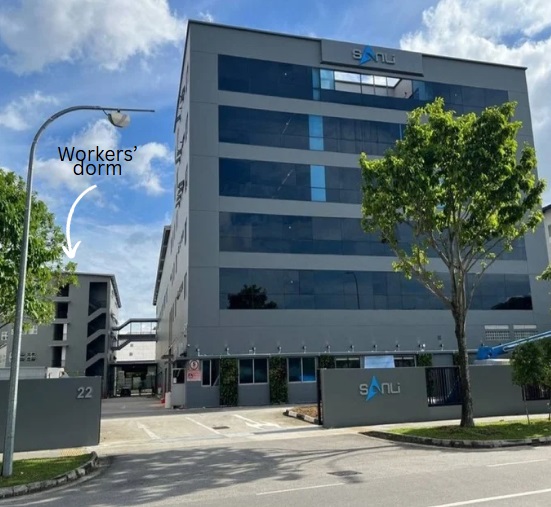| Sanli Environmental: Vision for a Greener, More Diversified Future Sanli Environmental has come a long way since its humble beginnings in 2006. |
Magnesium Hydroxide: The Next Growth Engine
In the last two years, Sanli has been actively transforming itself, and the magnesium hydroxide slurry business is at the heart of this pivot. 
At a corporate presentation this week, CEO Sim said: “Manufacturing by itself is something very different from what we have done all these years.”
It happened this way: Sanli was working as a contractor on Singapore’s Deep Tunnel Sewerage System when it recognised the future application of magnesium hydroxide for wastewater treatment.
Sanli set up a S$2 million pilot plant at its factory in Singapore to produce the chemical.
It's in high demand for reduce sulphur emissions from marine vessels and in treating agriculture waste, pointing to a long runway for growth.
“Today, there’s no one manufacturing it, not only in Singapore, but also Southeast Asia,” said Mr Sim.
|
Stock price |
7.8 c |
|
52-wk range |
6.8 – 11.5 c |
|
PE |
7.8 |
|
Market cap |
S$20.8 m |
|
Shares outstanding |
267 m |
|
Dividend |
4.4% |
|
1-yr return |
-23% |
|
P/B |
0.6 |
|
Source: Yahoo! |
|
After two years of rigorous certification and testing, Sanli is approved as a supplier to a major MNC shipping group which owns about 900 vessels.
It is starting small: It has supplied to a vessel belonging to the shipping group in February, with another vessel by next month.
This saves enormous space on the vessels which, otherwise, would have to carry sufficient magnesium hydroxide slurry for their Europe-to-Asia trip and back.
The profit margin for Sanli is double-digit and the business can be scaled up either in Singapore or neighbouring countries such as Malaysia where the operational costs are lower.
Sanli's pilot plant can produce for 20 vessels a year only, so it's expected to be replicated in due course.
Other Diversification Moves: Solar and Dormitories
Sanli’s diversification push doesn’t stop at chemicals. The company is also making moves in solar power and worker dormitories.
- Solar in Thailand: Two years ago, Sanli set up a JV named Sanli-EnGreen. The focus is to go into asset ownership, supplying solar power to customers.
The model is to own the solar assets and sell electricity to hotels and factories at rates meaningfully below the local grid, with a payback period of four to five years.
The JV completed its first hotel project late last year and has begun work on two more hotels, with numerous enquiries from other hotels. - Dormitories: In late 2023, Sanli acquired a property in Chin Bee Drive, in Jurong, for its HQ, and it comes with a workers' dormitory (270 capacity), which management described as a strategic move.
CEO Sim said: “The dormitory results in savings in labor costs, which today all the contractors are crying over. We have also an intention to increase the capacity of the dorm to 450… That would bring us further revenue from rental to third parties.”
Low Margins: A Temporary Pain
Sanli’s recent years have seen lower margins, but management is upfront about the reasons.  Sanli CFO Fredrik Tan.“Margin was low because some projects are pre-COVID… there were delays which cost more. We were affected also by inflation, high interest rates.”
Sanli CFO Fredrik Tan.“Margin was low because some projects are pre-COVID… there were delays which cost more. We were affected also by inflation, high interest rates.”
Net margin in FY2024 (ended March 2024) was 2.2% (FY23: 3.9%).
Legacy contracts signed before COVID are tapering off while new contracts are priced at higher margins.
Borrowings: Fuel for Growth, Not a Red Flag
The balance sheet shows a fair bit of borrowing. A significant portion of this is project-related financing.
As Sanli took on more projects and revenue grows significantly (a compound annual growth rate of over 20% recently), more working capital was needed to fund these projects.
Think of it like needing to buy the ingredients before you sell the cake. This borrowing is generally short-term, often with a tenure of around 150 days, linked to the project timelines.
As projects get completed and payments come in, these borrowings unwind.
Thus most of the short-term debt ($27.8 million as at end-Sept 20224) is tied to project cycles, and unwinds as projects are completed.
The new Sanli building accounts for $10 million of the $11.1 million long-term debt.
|
What It Means for Investors Sanli is at a turning point. The core water business is steady, while the excitement is in new, higher-margin ventures. |







